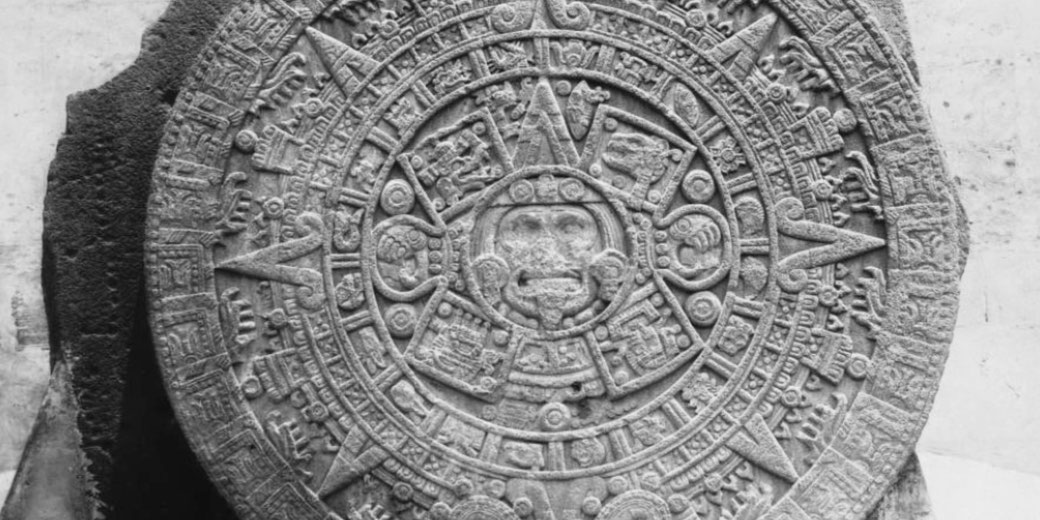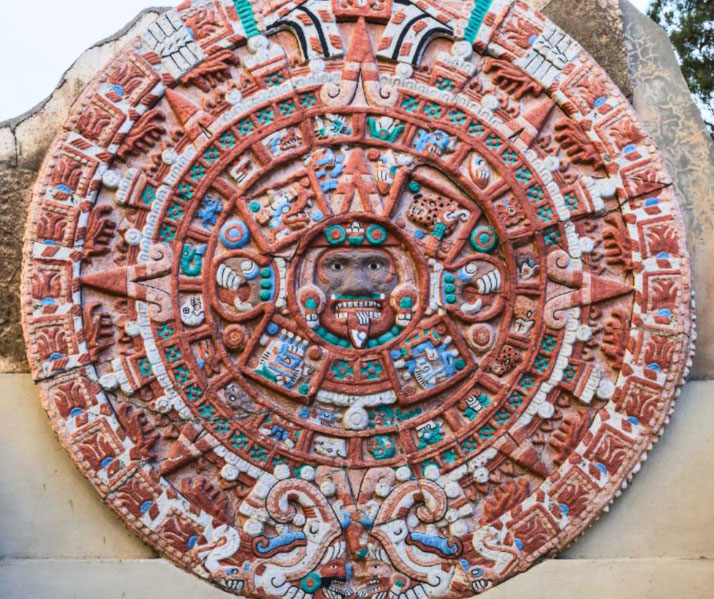The secret messages hidden in the Aztec Calendar

One of the most noteworthy accomplishments of Mesoamerican civilisation was the Aztec Calendar. Its carved designs with concentric rings and various symbolic images created a layered system of timekeeping that hid much about the Aztecs’ knowledge of astronomy and mythology, along with the ritual practices that shaped their society.
It is known more precisely as the Sun Stone, and much about its original use is still a mystery to us.
Where did the Aztec calendar come from?
Long before the Mexica founded Tenochtitlan in the 14th century CE, other Mesoamerican civilisations had developed timekeeping systems based on astronomical observation and religious belief.
The Olmecs, who flourished in the Gulf Coast region from about 1500 BCE, influenced the development of later calendar traditions, although direct evidence of a fully formed calendar system from them remains uncertain.
Later, the Maya improved and organised these systems, producing both a 260-day ritual calendar and a 365-day solar calendar, which became widely adopted in central Mexico.
In the centuries that followed, the Aztecs adapted these earlier systems to support the needs of their growing empire.
By the reign of Moctezuma II, who ruled from 1502 to 1520, the calendar had already become central to religious life and state power.
The timing of festivals, military campaigns, and harvests all depended on its accuracy.
Priests received expert training to interpret its cycles, and only they could perform the ceremonies required to maintain universal stability.
However, regional variations persisted in some areas, but the version kept in Tenochtitlan became the accepted model.
From the capital, scribes and astronomer-priests codified its structure, and formalised the meanings of the day signs.
In doing so, they reinforced the ideology that placed the Mexica at the centre of a religiously structured world.

The incredible sophistication of its design
Two interlocking cycles defined Aztec timekeeping. The tonalpohualli, or sacred calendar, ran for 260 days and arranged time into sets of 13 days, each associated with one of 20 named signs.
Each sign repeated in a cycle, and combined with the numbers 1 to 13, which created 260 unique date combinations.
As a result, every date had ritual meaning and influenced matters such as divination and sacrifice, along with the naming of newborn babies.
In contrast, the xiuhpohualli, or solar calendar, was made up of 18 months, each with 20 days, and added five extra nemontemi days to complete a 365-day year.
People regarded these additional days as dangerous and, as such, they avoided all major decisions and rituals during this short period, fearing that the favour of the gods had withdrawn.
The solar calendar helped order agriculture and official activities, and it allowed priests to regulate seasonal events with remarkable accuracy.
What each of the symbols mean
In the middle of the Sun Stone is the carved face of Tonatiuh, the sun god, who has a sacrificial blade for a tongue and holds human hearts in each hand.
His grim expression and features were meant to communicate the necessity of sacrifice to maintain cosmic order.
Four surrounding panels represent the destroyed worlds that came before the current era: 4 Jaguar, 4 Wind, 4 Rain, and 4 Water.
Each world ended in disaster and gave rise to the next, which reinforced their belief that time moved in cycles of creation and destruction.
Each previous sun had been ruled by a different god, such as Tezcatlipoca, Quetzalcoatl, Tlaloc, and Chalchiuhtlicue.
Alternative versions of this myth exist, and some sources disagree on the sequence and identities of the ruling gods.
Encircling Tonatiuh was the 20 day signs of the tonalpohualli that appear in a set sequence.
These include signs such as Cipactli (crocodile), Ehecatl (wind), Tochtli (rabbit), Ocelotl (jaguar), Tecpatl (flint), and Atl (water).
Priests used these combinations to determine favourable days for events such as war, planting, or sacrifice.
Near the outer edge, triangular rays extend from the centre like sunbeams and divide the stone into the four quarters, which corresponded to the cardinal directions.
Along the rim, two fire serpents known as Xiuhcoatl curl around the disk. Their tails meet below Tonatiuh, and their mouths face one another at the top, where they enclose human figures that personify time.
These serpents represent both solar energy and cyclical movement and frame the entire design in a religious story of destruction and rebirth.
The hidden astronomical calculations of the calendar
Aztec priests kept detailed records of celestial patterns when they studied the movement of the sun, moon, and planets to predict eclipses, solstices, and the agricultural seasons.
Temples such as the Templo Mayor were even aligned with the rising and setting sun at specific times of the year, which was thought to help in the observation of solar events.
Some scholars suggest the sun rose directly between the twin shrines on dates connected with the agricultural cycle, such as 4 May and 9 August, rather than precisely at the equinox.
In their ritual calculations, the 260-day tonalpohualli fulfilled several purposes. It matched the average length of human pregnancy, determined the timing of religious ceremonies, and aligned with the phases of Venus, which was associated with Quetzalcoatl as both morning and evening star.
The 365-day xiuhpohualli tracked the solar year, and although it lacked leap days, so the priests made adjustments to keep it aligned with the seasons.
Over generations, priests charted the positions of stars and planets during key events, so that they could build predictive models and identify recurring signs.
In interpreting the sky, the Aztecs believed they were reading the gods’ plans.
What happens when the calendar ends?
At the conclusion of the 52-year cycle, dread overtook the population. People feared that the sun might fail to rise and that the world would descend into eternal darkness.
On the final night, all fires were put out, and the city lay silent. Families climbed onto their rooftops and waited while priests carried out the ritual of the New Fire Ceremony on the summit of Huixachtlan.
During the ceremony, the priests sacrificed a man and attempted to kindle a fire in his chest. A
ccording to some traditions, the fire was kindled in the chest cavity after the heart had been removed.
If the fire caught and the stars moved as expected, runners transported the flame to every district of Tenochtitlan and then to the rest of the empire.
The event confirmed that the gods had allowed the cycle to continue, and life could begin again.
Following the arrival of the Spanish in 1519, the calendar ceased to function as a living ritual instrument.
Its priesthood vanished, and its meaning faded from memory as churches replaced temples and Christianity replaced the old gods.
Figures such as Archbishop Zumárraga ordered the destruction of sacred artefacts, and only fragments of indigenous knowledge survived.
The Sun Stone was buried beneath the city and forgotten for over two centuries.
After its rediscovery on 17 December 1790 during construction works near the Cathedral of Mexico City, the calendar became an item of historical interest and cultural identity.
The basalt disk, which measured about 3.6 metres in diameter, over 1 metre thick, and weighed approximately 24 tonnes, may once have stood vertically as a large-scale display or lain horizontally at the base of the Templo Mayor.
Later misunderstandings, particularly the confusion with the Mayan calendar, led to false predictions that it foretold the end of the world in 2012.
That association was entirely modern and had no basis in Aztec belief. The Aztecs had never expected a final end to time.
What do you need help with?
Download ready-to-use digital learning resources
Copyright © History Skills 2014-2025.
Contact via email
With the exception of links to external sites, some historical sources and extracts from specific publications, all content on this website is copyrighted by History Skills. This content may not be copied, republished or redistributed without written permission from the website creator. Please use the Contact page to obtain relevant permission.





